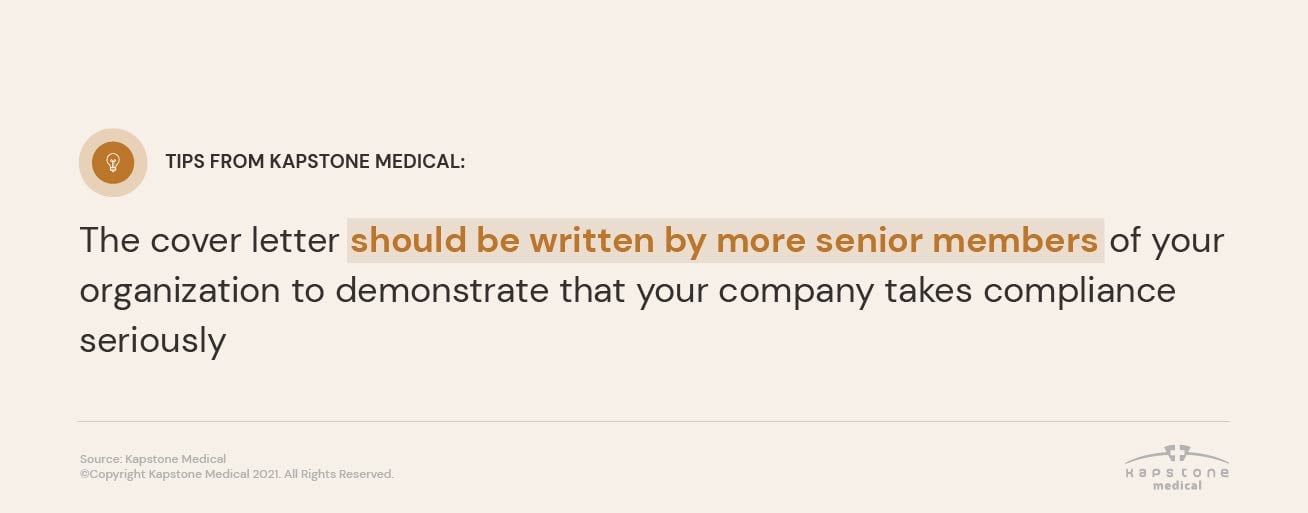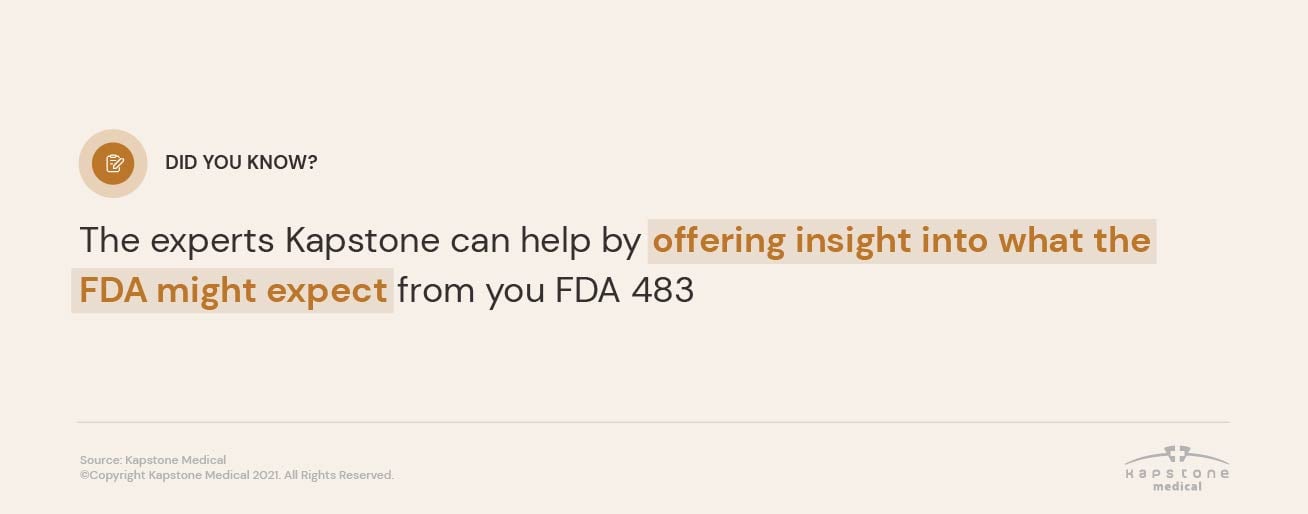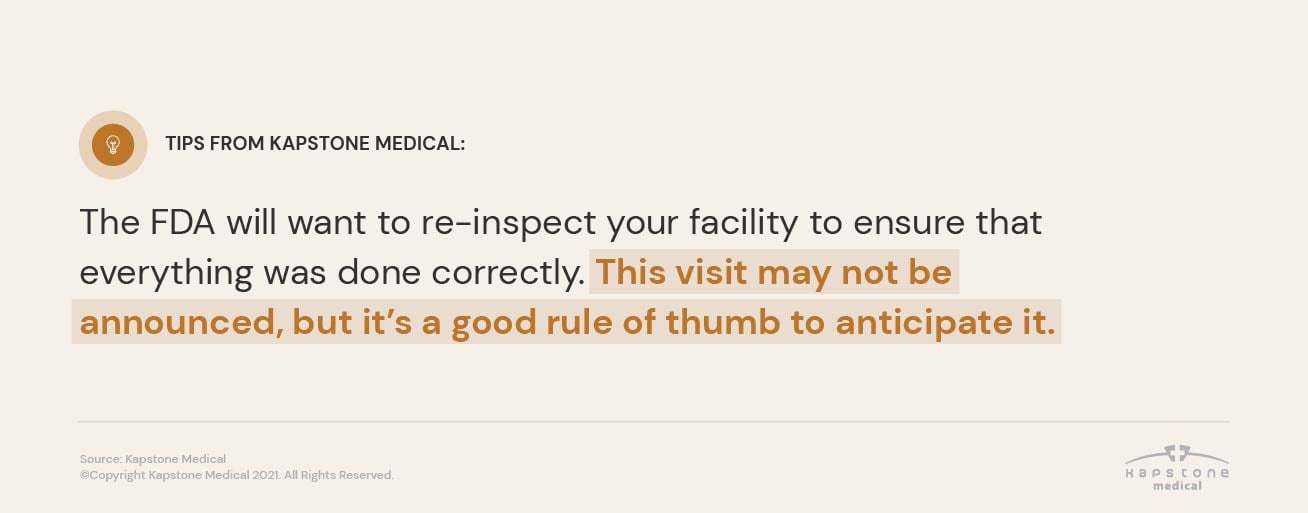FDA inspections are part of doing business as a medical device company in the United States. Sometimes, the FDA will issue a notice known as FDA Form 483 after their inspection. In this blog, we’ll help you understand why these notices are issued and how your organization should respond in the event that you receive one.
Keep in mind that while the FDA 483 should be taken seriously and addressed as quickly as possible, it is by no means a “death sentence” for your business. It does not represent the FDA’s final decision. You will have time to respond and make the necessary changes to your business or product—both of which the team at Kapstone can help you with.
Feel free to contact us with any questions before or after reading through these tips.
What does a 483 from the FDA mean?
Medical device companies doing business in the United States are expected to comply with FDA regulations. When an FDA inspector observes conditions or practices that do not comply, they will issue an FDA Form 483 to that company.
Inspectors are trained to be detailed and comprehensive in Form 483. They will also make themselves available to your management team to discuss their observations. Feel free to ask any and all questions at this stage—you’ll want to make sure you understand the Form 483 observations and what you need to do to correct them.
The most common FDA 483 observations are:
- Existing procedures not being followed
- Procedures are not clearly documented
- Insufficient Corrective & Preventive Action (CAPA) procedures and processes
Structuring Your FDA 483 Response
When drafting your response, it’s best to follow a standard outline. That outline has 3 parts:
1. Cover Letter
Approach this section as an opportunity to thank the FDA for their time and attention. Then, state your renewed commitment to FDA compliance and promise to mitigate anything that was documented in Form 483. Do not go into too much detail—that’s what the body of your response is for.
This section is best written by more senior members of your organization. This will demonstrate that your company takes compliance seriously and that your mitigation strategies will be enforced from the top down.
2. Body
This is your opportunity for detail—the more relevant detail, the better!We suggest that you restate each Form 483 observation. You can use the text from the form itself for consistency. Then, provide the following for each observation:
- Relevant background or contextual information
- Assess the root cause
- Proposed corrective actions (be detailed and include target completion dates)
- Measurement plan for corrective actions (how will you show that your actions were successful and enabled compliance?)
- Preventive actions (particularly if the FDA found systemic issues)
- Measurement plan for preventive actions
3. List of Attachments
This is a flexible section. Attach anything that will strengthen your case to the FDA, such as background information, standard operating procedures (SOPs), your CAPA measurement plans, and more.
Whatever you include, be sure to clearly describe and label each attachment. Ensure that numbering/naming between the body of your response and the attachments matches up.
10 Tips on How to Respond to an FDA 483
Now that you understand why you might receive an FDA Form 483 and the basic components of the response, let’s talk about how to optimize your response.
1. Act Quickly
You will have 15 business days from the date of issuance to respond to an FDA Form 483. Failure to respond will likely result in an official FDA warning letter.
Do what you can to reprioritize other business activities and commit your time to this response. The 15 days will go quickly, even if you only have a few observations to respond to.
2. Determine Root Cause
Start by identifying the root cause of each 483 observation. You may already have root cause analysis procedures in place; if not, now is the time to implement them, including relevant root cause analysis tools (e.g., 5 Whys, Fishbone Diagram, Failure Mode and Effects Analysis, etc).
Work backwards from each anomaly to identify its origin (or origins). Consider whether the anomaly resulted from routine error or a true defect in your system. If it is the former, you may need better risk mitigation procedures or more comprehensive training for the involved employees; if it is the latter, you may need to reassess how your system is set up.
Be sure to document your findings. Root cause analysis is a core part of the body of your FDA 483 response.
3. Assign a Corrective Action Plan
After identifying where your issues arose, your next step, naturally, is to mitigate them and prevent them from happening in the future. This is done by assigning individual Corrective & Preventive Action (CAPA) plans for each FDA 483 observation.
Record the following for each FDA 483 observation:
- Description of the issue (suggest copying and pasting the 483 observation)
- The root cause or causes
- Immediate corrections
- CAPA plan to prevent the issue from happening again
- Who is assigned to “own” this CAPA and, if required, the training they will undergo
4. Set a Realistic Timeline
While the FDA expects to see progress documented in your initial 15-day response, it is not reasonable to expect that you will be able to correct all the issues in that window. You definitely don’t want to make promises to the FDA that you can’t keep!
Instead, set an urgent but realistic timeline for each observation. Be honest with yourself and your employees about how long it will take to implement changes and CAPA plans.
Include your timelines in your FDA 483 response.
5. Write the First Draft
After you’ve identified the root cause of each observation and made a plan for how to fix it (and prevent the issue from happening in the future), it’s time to write your first draft.
Prioritize accuracy in the first draft, ensuring that you record all of the information correctly. Once you have your factual framework, you’ll be able to add structure, context, and detail around it.
6. Be Clear, Compelling, and Thorough
The narrative of your response should be easy to follow: what was the problem, what was the cause, what have you done or plan to do to fix it, and when will it be complete? Follow this narrative framework for each 483 observation.
Add as much detail as you can in terms of your planned mitigation strategies. There should be no doubt from the FDA’s perspective that you understand their observations and are prepared to implement effective solutions.
Include and refer to attachments as needed. Ensure that your attachments are organized and easy for the FDA to find and reference.
7. Know and Address What’s Expected
We’ve already discussed the core parts of what the FDA is looking for: understanding of the problem and identification/implementation of a solution.

However, you can make your response even more convincing by anticipating the FDA’s questions. For example: if your CAPA plan for a specific observation involves more employee training, be detailed about what that training will look like. The FDA will want to understand what the employees will learn and how their performance will be measured.
You can always rely on the experts at Kapstone for insight into what the FDA might expect.
8. Cite Supportive Facts and Data
The FDA has no interest in fluffy, unsubstantiated claims. Whether you’re claiming a result, new capability, or just a promise, you have a responsibility to back it up with hard evidence and data. For each result, detail how you got there and how you measured it; for each new capability, show how you developed it and how you’ll maintain it effectively; for each promise, show how you plan to keep it—and so on.
Attachments are a great place for data tables and other supporting evidence. As always, be sure the attachments are organized and easy for the FDA to reference.
9. Provide Regular Updates
Unless you are miraculously able to address every FDA 483 observation in your initial 15-business day window, you should plan to update the FDA on your progress at least every 4-6 weeks. The number of updates you provide will depend on the volume and scope of your observations.
Include detail on when you plan to send out updates in your initial response. This will also help your team structure your workload over the next few months, as you’ll have hard FDA deadlines to work towards.
10. Prepare for Re-Inspection
Once you’ve implemented corrective and preventive action for each 483 observation, the FDA will want to re-inspect your facility to ensure that everything was done correctly. This visit may not be announced, but it’s a good rule of thumb to anticipate it.

The good news: if you’ve done everything correctly and recommitted yourself to excellence in compliance, you should have nothing to worry about. Even if the FDA does find another infraction, you’ll be able to address it with a greater understanding of the FDA 483 response procedure.
You can also bring any questions or concerns to the team at Kapstone. Our regulatory team has helped several clients through the FDA 483 response. Contact us today to get started.


